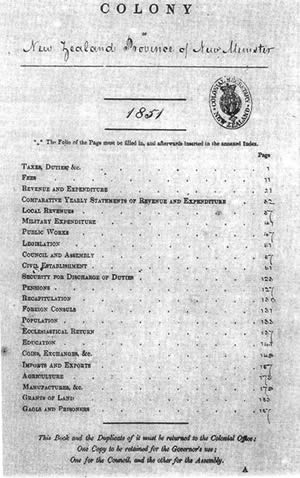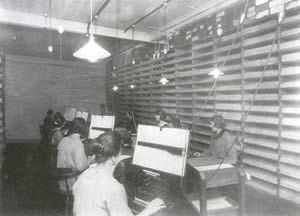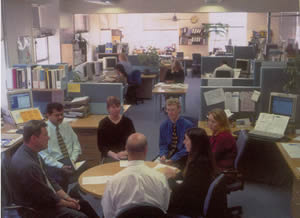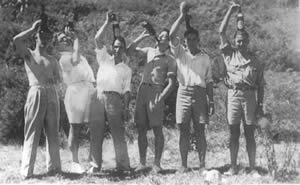Beginnings
Statistical work has always involved collecting, analysing and presenting data. What has changed is how this is done – and the types of data collected. In New Zealand’s early colonial years, officials such as magistrates and policemen collected information about people and economic activities as they went about their duties. A handful of male clerks in the Colonial Secretary’s office collated this data and summarised the results on standardised forms which were bound together in volumes known throughout the British Empire as ‘Blue Books’. Annual statistical reports were published by the Government Printer from the 1850s.
For a century from the 1890s, the New Zealand Official Yearbook was the main means of communicating statistical information to the public. Many staff co-ordinated, updated and checked the material contributed by other government departments. In recent years much of this information has been made available online.
The 1851 ‘Blue Book’ for New Munster (a province consisting of all of New Zealand south of a line drawn due east from the mouth of the Pātea River)
More about this image
Collecting data
Counting people (and animals – the last census question about poultry was asked in 1971) required much effort. Initially, men with close knowledge of their communities, such as police and post office workers, collected data on the ground. Pre-motorised travel was hazardous, and at least one sub-enumerator suffered ‘the New Zealand death’, drowning while crossing a river on horseback. In the early 20th century, agents such as grocers distributed family budget surveys. Later, information was increasingly collected by post as comprehensive coverage gave way to sample surveys. Census forms are still delivered to every household in the country by a wide variety of methods. Gaining access to inner-city apartment buildings has been a recent challenge.
Tabulation techniques
As both New Zealand’s population and the complexity of the information sought grew, so did the size of the army of temporary clerks that was employed every five years by the Census and Statistics Office to process it. Sitting at long tables in draughty or cramped rooms, they laboriously added, subtracted and calculated percentages. From the 1890s census data was written on cards which were sorted by hand. The drudgery of statistical work was gradually eased as adding and calculating machines and typewriters came into use, operated mostly by women. In the 1920s tabulating machines were imported from the United States to process punched cards; this too was women’s work.
Machinists work on 1921 census data
More about this image
The introduction of computers
The Census and Statistics Office employed a few economists, including the well-known J.B. Condliffe, after the First World War, but no fully qualified mathematicians until after the Second, when in-house training in statistical methods also began. By the 1960s the population census was barely being processed by the time the next one was taken. A second-generation IBM mainframe computer acquired by the Statistics Department was soon obsolete, and the Government Computer Centre was unable to process the data for series such as the Consumers Price Index quickly enough. Since the early 1980s computing has been done in-house, and in the 1990s personal computers and the Internet revolutionised the day-to-day experience of work at Statistics New Zealand.
Working conditions
New Zealand’s statistical workers have enjoyed or endured a wide variety of working conditions in central Wellington over the years. Early ‘highlights’ included the former parliamentary boilerhouse; the ‘dirty, dank and unsanitary hole’ of the Wairarapa Farmers’ Co-operative Association building, in which they coexisted with a thriving rat population; and the attic of the Public Trust building. Newer accommodation wasn’t always much better: the concrete Hood’s building between Lambton Quay and The Terrace was state-of-the-art for 1925, but staff either shivered in the ‘Dungeon’ or sweltered on the ‘Sunnyside’; the window frames soon leaked and let through draughts; the plumbing ‘went on the blink’. After decades spread across a growing number of rented offices of varying quality, head office at last became ‘comfortably housed’ in 1974, when it moved into Aorangi House in Molesworth St. Since 2005 Statistics New Zealand has occupied Statistics House, a ‘green glass box’ on the waterfront with a facade that apparently ‘alludes to both the magic of numbers and the colour of the sea in the harbour nearby’. Inside, a wide stairway and ‘social areas’ on each floor encourage staff to interact.
A more modern office
More about this image
Extra duties
Statistics staff have sometimes taken on additional duties. During the First World War, for example, several hundred temporary staff, mostly women, compiled information on every male of military service age and carried out the periodic birthdate ballots for conscription. In the Second World War these duties were undertaken by a separate National Service Department.
Staff having fun
There has always been play as well as work. A table tennis craze in the 1920s was short-lived, but sport, picnics and office parties have endured. In 1956, the newly created Department of Statistics had 92 male and 72 female employees. In 2010 there were approximately 850 full-time staff, more than half of them based outside Wellington and 55% of them female.
The Census and Statistics Department’s annual staff picnic, Paekākāriki, 1938
More about this image
Content based on material from David Green, Statistics Count: An Illustrated History of Statistics New Zealand, Statistics New Zealand, 2002. ISBN 0-478-20797-2




